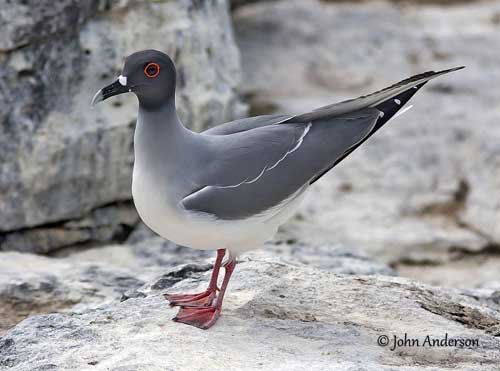
Fr: Mouette à queue fourchue
All : Gabelschwanzmöwe
Esp : Gaviota Tijereta
Ital : Gabbiano codadirondine
Nd : Zwaluwstaartmeeuw
Sd : Svalstjärtad mås
Esp (Chile): Gaviota de las Galapagos, Gaviota de las Galápagos
Esp (Colombia): Gaviota Rabihorcada
Photographers:
John Anderson
John Anderson Photo Galleries
Tom Merigan
Tom Merigan’s Photo Galleries
Text by Nicole Bouglouan
Sources:
HANDBOOK OF THE BIRDS OF THE WORLD Vol 3 by Josep del Hoyo-Andrew Elliott-Jordi Sargatal - Lynx Edicions - ISBN : 8487334202
A GUIDE TO THE BIRDS OF COLOMBIA by Steven L. Hilty and William L. Brown - Princeton University Press – ISBN 069108372X
BirdLife International (BirdLife International)
Wikipedia, the free encyclopaedia
Swallow-tailed Gull
Creagrus furcatus
Charadriiforme Order – Laridae Family
BIOMETRICS:
Length: 51-57 cm
Weight: 610-780 g
DESCRIPTION:
The Swallow-tailed Gull is a large bird, the most nocturnal of all species with characteristic large eyes. It is endemic to Galapagos Islands.
The adult in breeding plumage has dark grey head with white spot at base of the bill. The plumage becomes paler grey on upper neck and breast.
On the upperparts, mantle, back and wings are grey. On the upperwing, the outer primary flight feathers are black. In flight, we can see a large white triangular wing patch. A narrow white stripe separates on each side the back from the wings. Rump and deeply forked tail are white.
The underparts are pure white except the pale grey upper breast and the black wing tips.
The bill is blackish with pale bluish or greenish-white tip. The eyes are dark brown, surrounded by bright red eyering. Legs and webbed feet are pinkish-red.
Both adults are similar. In non-breeding plumage, they are mainly white with pale grey upperparts, black eyering and duller legs and feet.

The juvenile has spotted and streaked black upperparts, buffy-white head and underparts, black bill and eyes and whitish legs and feet.
The immature is white with heavy dark brown spotting and streaking on upperparts. The tail shows a black subterminal band. Bill and eyering are black. Legs and feet are pale pinkish-white.
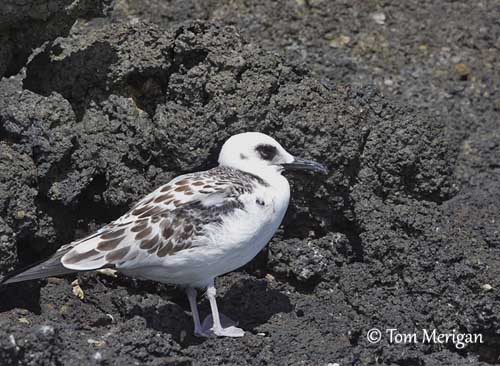
VOICE: SOUNDS BY XENO-CANTO
The Swallow-tailed Gull utters thin, harsh, gurgling screams with head moving side to side, and also produces a rattle very different of all gull’s sounds. Both mates gives greeting calls, some loud, rapid “kweek, kweek, kweek”.
HABITAT:
The Swallow-tailed Gull breeds on steep slopes, often on broad cliff top ledges on islands. But the nest-site can also be established just above the waves’ area, on gravelly beaches and under vegetal cover.
Outside the breeding season, this species is fairly pelagic, often feeding far at sea, about 500 km from the nearest continent.
RANGE:
The Swallow-tailed Gull is found in the Galapagos Islands, usually in eastern half of the archipelago. It is also visible on Malpelo Island, off W Colombia coast.
Outside the breeding season, this species is pelagic and migrates E to coasts of Ecuador, S Peru and N Chile.
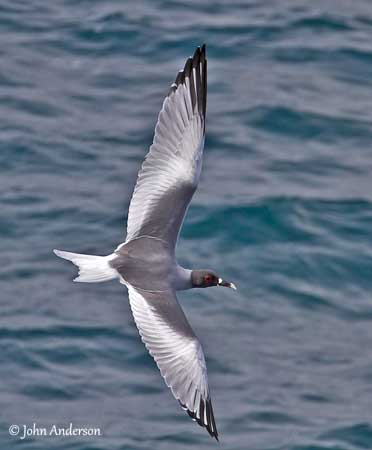
BEHAVIOUR:
The Swallow-tailed Gull feeds mainly at night, and this habit is unique among gulls. The nocturnal foraging is probably a good way to avoid the piracy by frigatebirds.
Thanks to its night-adapted large eyes, it can feed far from the shore, catching fish and squid from the surface.
During the breeding season, aggressive and courtship displays are reported.
Some threat displays may occur at colonies such as threat-gaping with bright red gape and mouth displayed in front of intruder or rival, aggressive upright-posture and some jerking movements.
But ritual displays such a mutual preening between mates occurs too. They perform head-tossing, flinging the head up over the back and giving a plaintive note.
The male performs courtship feeding by regurgitation of food to the female. This is a typical pre-laying behaviour.
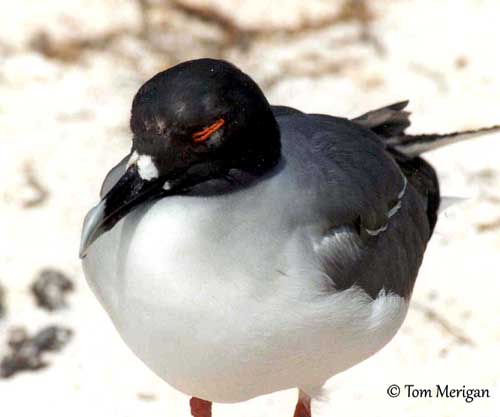
FLIGHT:
The Swallow-tailed Gull is agile in flight and disperses far out of sea outside the breeding season. The fly display is butterfly-like, associated with snore-scream calls.
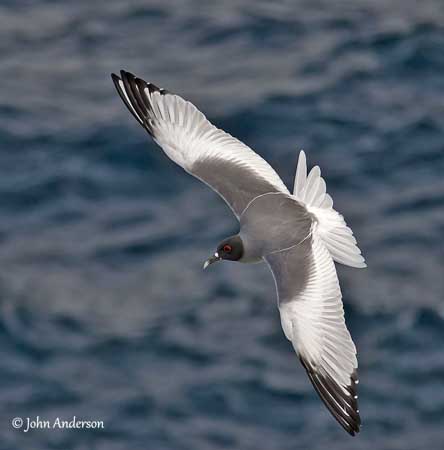
REPRODUCTION:
The Swallow-tailed Gull breeds all year round. The breeding cycle usually lasts six months, but in individual pairs, it may last nine or ten months.
They form loose colonies with well-spaced nests (about 30 pairs/200 square metres). Pairs often nest solitary too.
The nest is a shallow hollow on bare lava or gravel, often placed under rocks or bushes, and usually close to the sea. The hollow is lined with feathers, bones or pebbles, carried by the adults. They swallow pebbles and regurgitate them at nest.
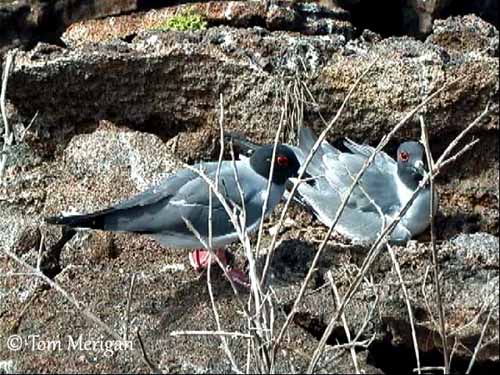
The female lays a single buffy-white egg with brown markings. Both sexes incubate during 33-35 days, with 24 hours’ shifts.
During the night, the non-incubating parent flies out to the sea. It forages thanks to its nocturnal adaptation, and catches squid, its preferred food. It returns to the nest at dawn.
At hatching, the chick is covered in cryptic down. It is brooded continuously during the first two days. It will remain near the nest for several weeks, attended by both parents during the daylight. It fledges 58-65 days after hatching, but it still depends on parents for long time, about 90-140 days. It remains near the colony during this period. However, it does not return to its natal colony to breed.
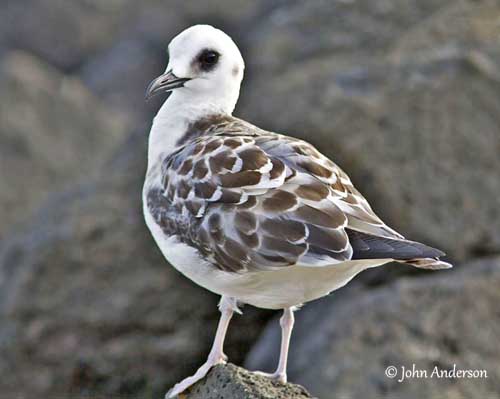
DIET:
The Swallow-tailed Gull feeds mostly at night. It feeds primarily on squid and also fish. It takes preys from the surface.
PROTECTION / THREATS / STATUS:
The Swallow-tailed Gull is not currently threatened. Although the breeding range is relatively reduced to islands, the colonies are protected by Galapagos National Park. But increasing human disturbance and fishery activity might be future threats for this species.